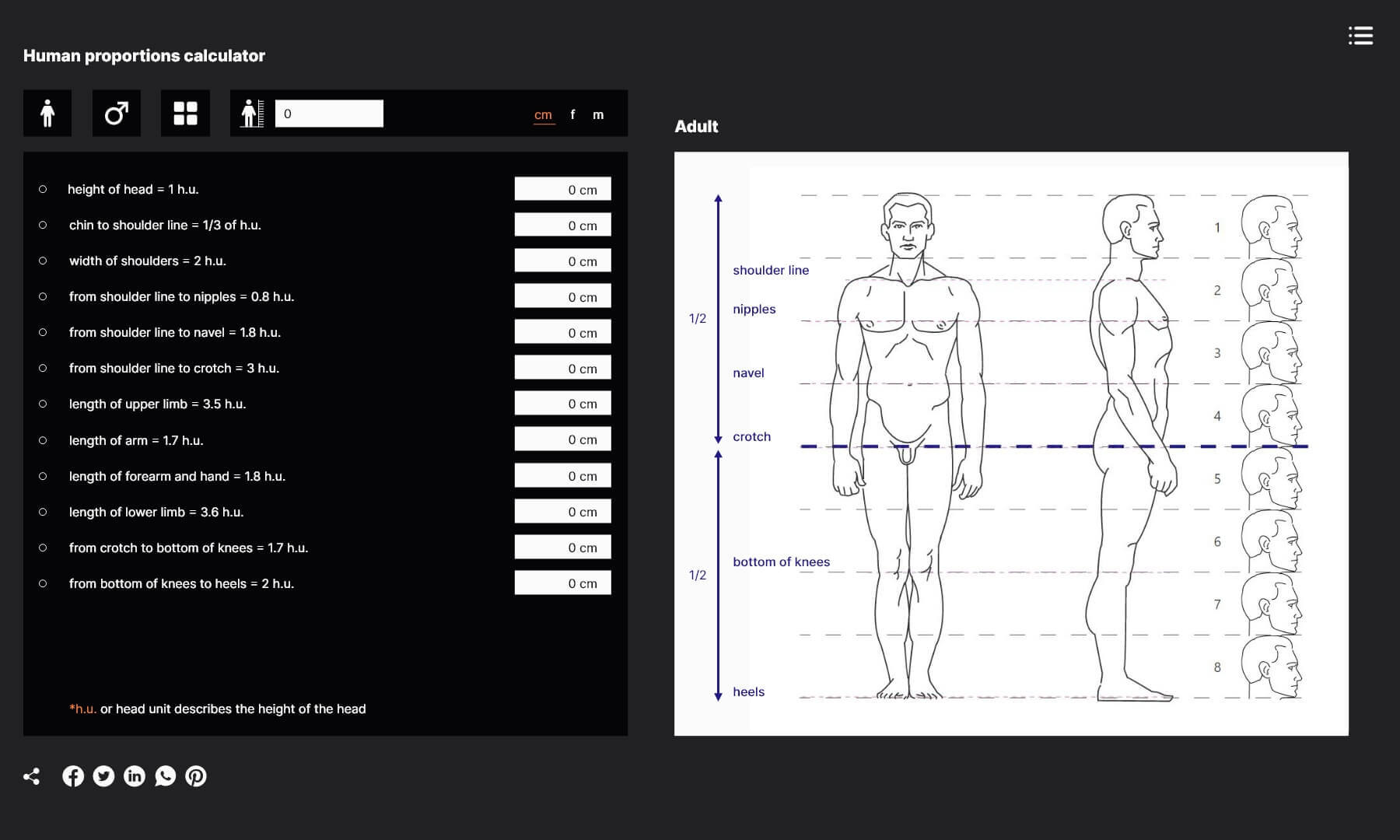
About human proportions calculator
This tool provides a simple and fast way to know the proportions of an ideal and realistic human figure. It proposes an easy way for an artist to understand what the human body proportion sizes are.
Butt anatomy is a challenging subject for many artists. First of all, humans are the only animals with abundant butt fat. And the butt has the Gluteus maximus – the biggest muscle in the entire human body.
With all this squishiness, it’s hard to understand where to begin when creating a butt, especially since both fat and muscle vary a lot depending on the age, sex and body type of the person.
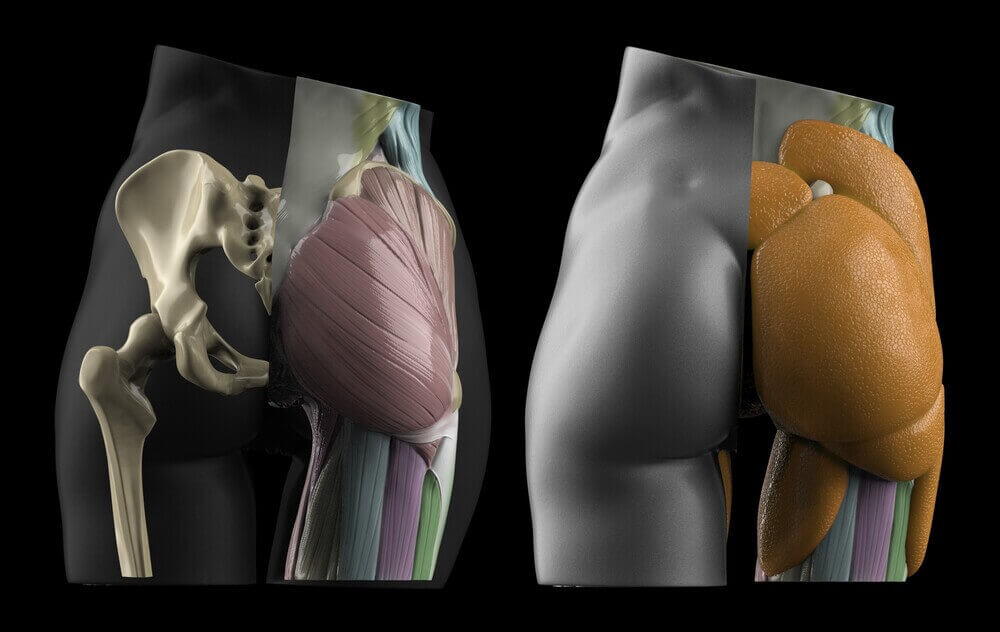
So butts have an exceptional anatomy. But it’s not all a soft squishy mess, so don’t despair. There are still bony landmarks, muscle origins and insertions that we can follow. The multiple fat pads of the hips and butt have concrete names, forms and locations that we can learn.
In this blog, we’ll cover the muscles and fat pads of the butt. We will do this by reviewing the main differences between male and female butts, which differ quite a lot.
If you’re interested in the bony landmarks of the butt, check out our previous blog on this subject. We’re also preparing our next article on male and female butt variations and butt forming tips.
The challenge: Standard anatomy books don’t show this!
Before we dive into the detailed anatomy of the butt, I want to highlight a challenge that artists always have when dealing with the usual anatomy materials. The example is a straightforward one.
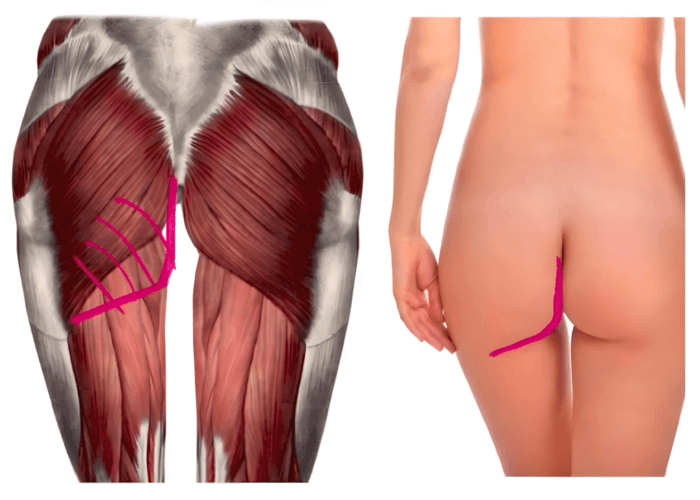
Regular anatomy books vs. a real butt: the Gluteal fat and the Gluteal crease are missing.
When depicting the butt, the Gluteal crease and the Posterior gluteal fat pad (or Medial gluteal fat pad for males) are extremely important. Yet, you won’t find much information about these elements in a regular anatomy book, which usually shows just the muscles.
Medial gluteal fat pad
The Medial gluteal fat pad is located in the medial inferior part of the buttocks, and it is crucial in making the form of the buttocks complete. Just see for yourself! In females, it is a part of a larger structure called the posterior gluteal fat pad. The picture below shows how much of the butt would be missing if there was no Medial gluteal fat pad!

The Medial gluteal fat pad and the Gluteal crease on a male butt.
The Gluteal crease forms because the Gluteal band runs horizontally across the Gluteus maximus muscle and the Medial gluteal fat pad, splitting them both in two parts. The resulting depression is called the Gluteal crease, which is chiefly responsible for the round form of the butt.

The Gluteal band presses on the Gluteus maximus and creates the Gluteal crease.
Conventional anatomy books fail to mention the role of the Gluteal crease and don’t explain that the final rounded form of the butt doesn’t match the borders of the Gluteus maximus muscle.
The Medial gluteal fat pad and the Gluteal band are crucial elements that shape the buttocks, and understanding their importance is key for artists in accurately depicting the butt. This is just one such example, so let’s move on to other elements!
Muscles of the butt are crucial in creating its form, especially if it’s a male butt. While the fat pads in the buttocks indeed have a significant impact on the overall appearance of the butt, providing it with volume and roundness, the role of the muscles should not be diminished.

Male posterior and side views of the three main muscles of the butt.
More pictures like this on Anatomy for Sculptors ArtStation.
In particular, for male butts, the muscles are often very visible in the final form. Knowledge of the shape provided by the muscles is essential to create a realistic depiction of the buttocks. Therefore, artists must understand both the muscles and fat pads of the butt to depict its form in their work accurately.
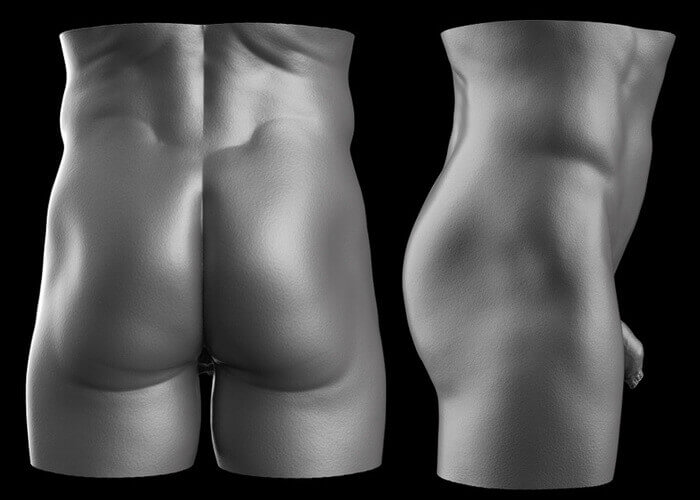
Muscles of the butt are evident in the surface forms of the male butt.
The Gluteus medius, Gluteus maximus, and Tensor Fasciae Latae muscles are essential for understanding and creating the form of the buttocks. These muscles originate from the iliac crest and form a wheel-like structure around the Greater Trochanter, which can be imagined as the axis for this wheel.

Female posterior and side views of the three main muscles of the butt.
The Gluteus medius muscle plays a critical role in the form of the buttocks. It acts similarly to the deltoid muscle in the arm, pulling the limb away from the body with multidirectional fibers that allow it to pull the limb forward and backward.


Male and female posterior and side views of the Gluteus medius muscle.
The Gluteus medius originates from the front three-quarters of the iliac crest, with part of its origin also covered by the Gluteus maximus. It inserts into the Greater Trochanter and contributes to the shape and movement of the buttocks.
The Gluteus maximus is the largest muscle in the human body. It is crucial in the anatomy of the buttocks.


Male and female posterior and side views of the Gluteus maximus muscle.
Most of its fibers insert into the iliotibial band, allowing it to extend the femur, laterally rotate it, and abduct it, with lower fibers also contributing to adduction. The Gluteus maximus helps to create the shape and volume of the buttocks while also playing a vital role in the movement.
The Tensor fasciae latae is a muscle located around your pockets, anchored at the ASIS (Anterior Superior Iliac Spine), and attached to the iliotibial band. It opposes the Gluteus maximus, with both muscles inserting into the iliotibial band and pulling it in opposite directions.


Male and female posterior and side views of the Tensor fasciae latae muscle.
The Tensor fasciae latae muscle flexes the leg forward, abducts it outwards to the side, and medially rotates it. Its shape changes depending on the position of the leg, becoming longer and flatter in a straight leg and bulging out in a flexed leg.
Together with the Gluteus medius and Gluteus maximus, the Tensor fasciae latae is essential in creating the overall appearance of the butt.
Butt fat and hip fat distribution varies a lot between males and females due to hormonal and genetic factors, and this is most visible in the hips and butt. While there are general differences in subcutaneous fat distribution between males and females, it’s important to note that individual variations do exist.
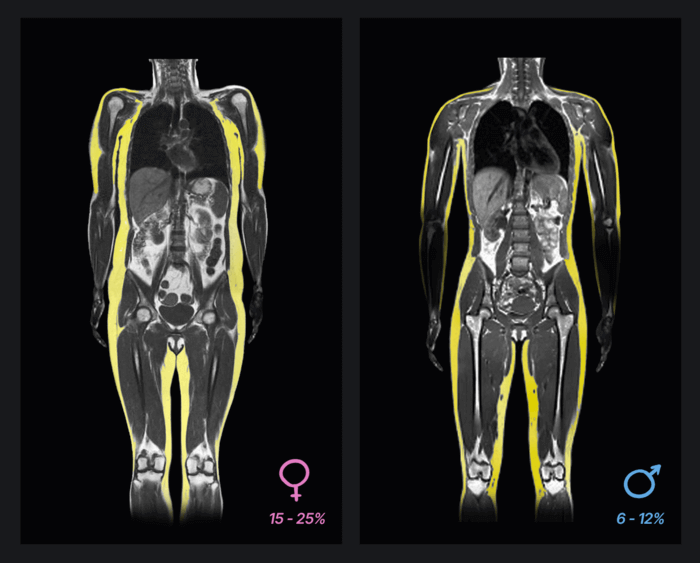
Body fat distribution in females and males with a similar body type – radiology scan.
Fat accumulates more in the buttocks and hips in females, resulting in a curvier appearance. Fat accumulation in these areas is typically lower in males, and the appearance remains quite angular compared to the curvier female shapes.
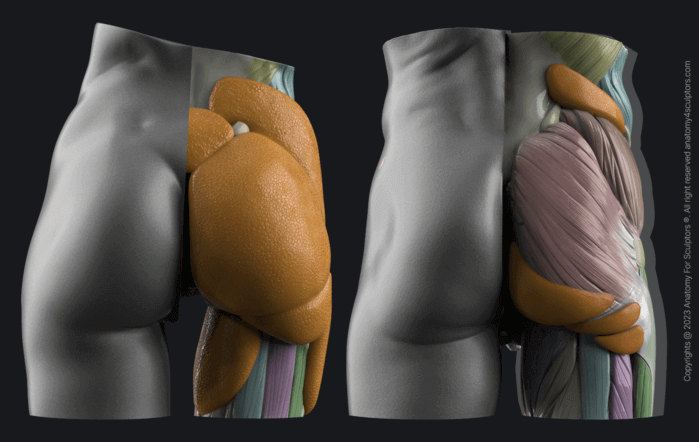
Female and male butt fat comparison.
Anatomical descriptions in medical literature rarely mention specific subcutaneous fat pads in the area of the hips and butt. These descriptions usually refer to broader regions. However, as artists, we must understand subcutaneous fat pads in more detail.
Male butt fat accumulation is typically low, and, as mentioned, you can see the shapes of the gluteal muscles in the surface forms of the male butt. That is because there’s typically not much fat in the male butt to cover them. Let’s look at the two fat pads that do affect the form of the male hips and butt.
The Medial gluteal fat pad covers the medial inferior part of the male buttocks, and it is crucial in making the form of the buttocks complete. It is the most notable fat pad in the male butt, and we already covered how incomplete the butt would look without it at the beginning of the blog.
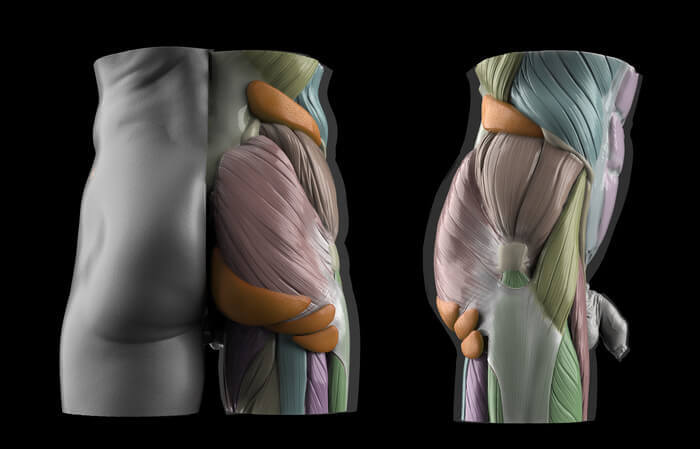
The Medial gluteal fat pad with the Inferior gluteal fat extension on the other side of the Gluteal band and the Flank fat pad on a male butt.
The Inferior Gluteal Fat Extension is a part of the Medial Gluteal Fat Pad found on the other side of the Gluteal band, which runs horizontally across the Gluteus maximus muscle and the Medial Gluteal Fat Pad splitting them both into two parts and is responsible for the roundness of the butt.
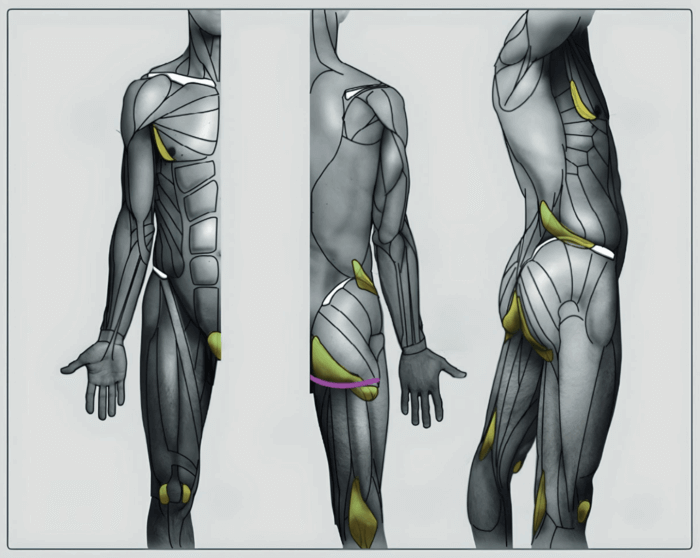
A diagram of the typical male fat pads.
The Flank fat pad is found on the sides of the waistline, around the Iliac crest area, and it’s the second most notable male fat pad. It extends from the hips to the lower back area.
These two fat pads – the Medial gluteal fat pad and the Flank fat pad – are typically the only ones affecting the form of the male hips and butt.
Female butt fat and hip fat accumulation fundamentally defines the visible appearance of the female hips and butt. Typically, you wouldn’t see forms of muscles and the Greater Trochanter on the surface forms of the female butt as you see them on the male butt because they’re all covered by these different fat pads.
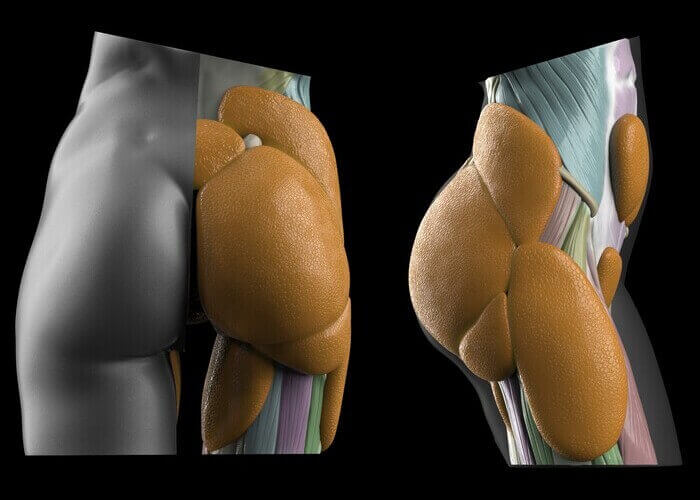
Female subcutaneous fat in the butt and hip area.
While males have two fat pads affecting their hips and butt, females have six fat pads directly affecting their hips and butt.
The Flank fat pad on females refers to the subcutaneous fat accumulating on the sides of the waist, right above the Iliac crest, extending from the hips to the lower back area.
The Lateral gluteal fat pad is the subcutaneous fat located at the upper part of the buttocks starting just below the Iliac crest and extending from the upper part of the Gluteus medius muscle towards the Sacral Triangle/Rhombus of Michaelis area.

Diagram of the typical female fat pads – posterior view.
The Posterior gluteal fat pad is the largest fat pad covering the buttocks, including all the subcutaneous fat located on the backside of the buttocks. It covers most of the Gluteus maximus muscle and a fraction of the Gluteus medius muscle.
The Inferior gluteal fat extension is the subcutaneous fat that extends from the Gluteal band at the lower part of the buttocks towards the upper part of the thighs.
The Outer thigh fat pad refers to the subcutaneous fat accumulating on the outer sides of the thighs, extending from the Greater Trochanter at the hips to the mid-thigh.

Diagram of the typical female fat pads – side view.
The Inner thigh fat pad refers to the subcutaneous fat accumulating on the inner sides of the thighs extending from the crotch to the mid-thigh.
The fat accumulation in females begins at a certain age. For example, a butt of a pre-puberty teenager would typically have no fat accumulation, and its surface forms would match the form of the muscles underneath.
The Rhombus of Michaelis is a diamond or rhombus-shaped area in the female lower back. It’s a region that combines the bony structures already mentioned as the Sacral Triangle and subcutaneous fat.

The Rhombus of Michaelis is a fat pad found on females; the Sacral triangle can be found on both males and females.
While the Sacral triangle is purely a bony landmark found on both the male and female lower back, the Rhombus of Michaelis is created by subcutaneous fat unique to women.
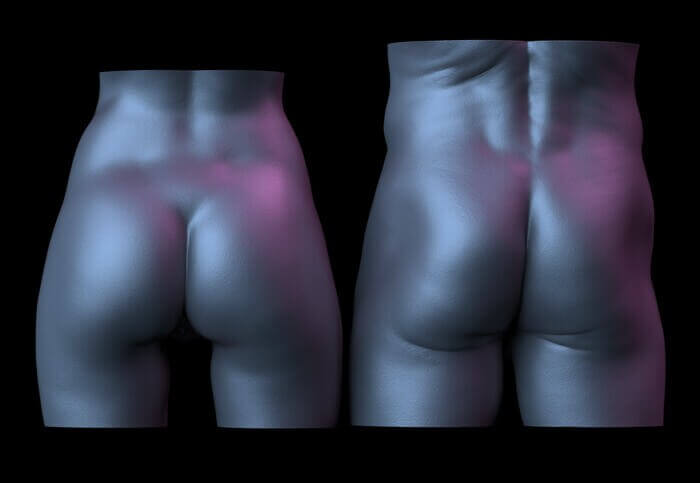
Comparison of the male and female butt with the Rhombus of Michaelis only visible on the female butt.
During pregnancy or specific movements, the subcutaneous fat in this region may stretch or shift, contributing to the appearance of the Rhombus of Michaelis and making it more prominent.
This covers the muscles and subcutaneous fat of the butt. If you want to learn more abut the bony landmarks and proportions of the butt, check out our previous blog! We’re also preparing our next article on male and female butt variations and butt forming tips, so be sure to return.
Be the first to get news about our upcoming discounts, books, tools, articles and more! No spam, just the good stuff.

This tool provides a simple and fast way to know the proportions of an ideal and realistic human figure. It proposes an easy way for an artist to understand what the human body proportion sizes are.
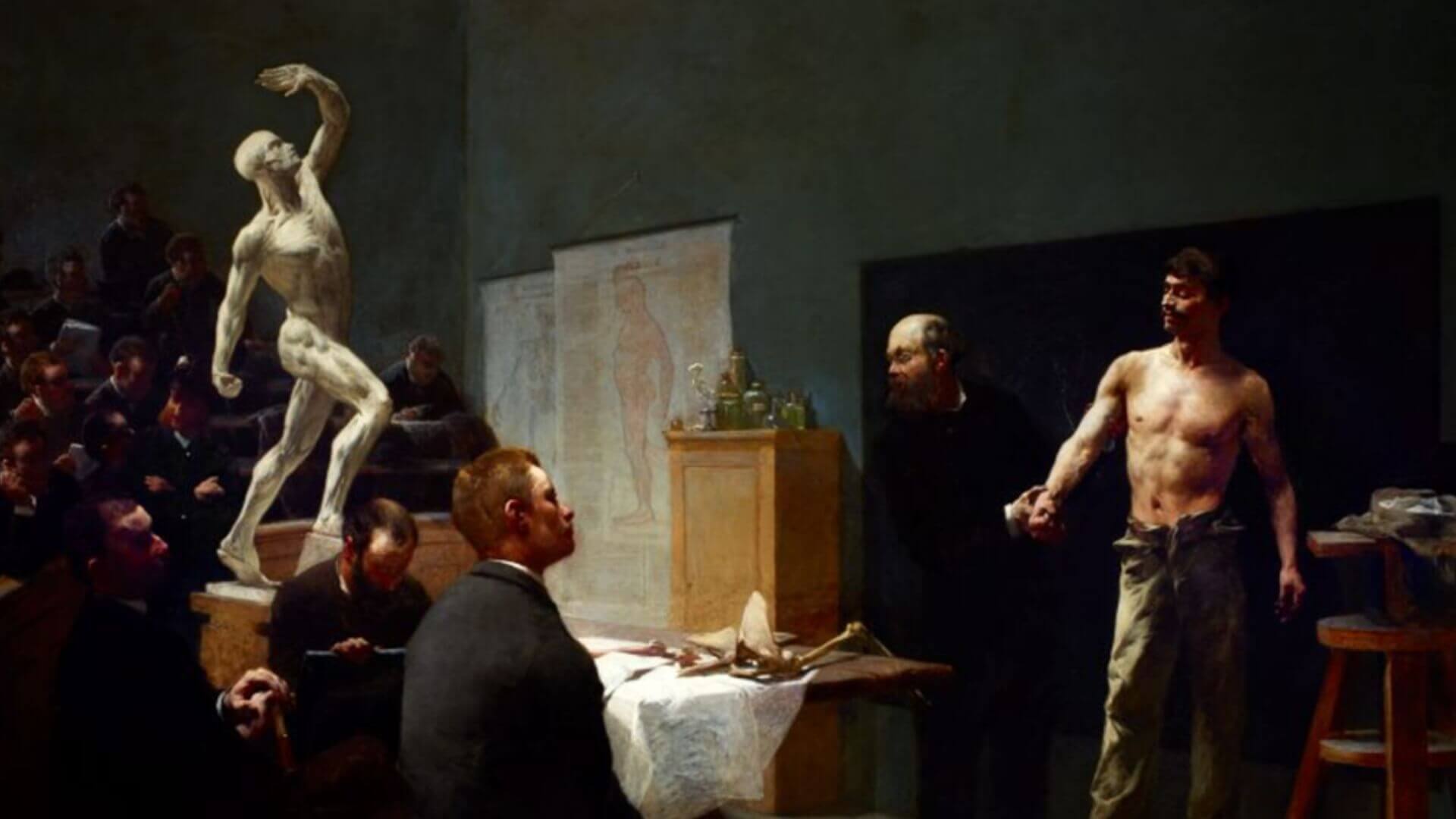
This is a story of a static figure becoming a powerful demonstration of the link between muscle and motion.